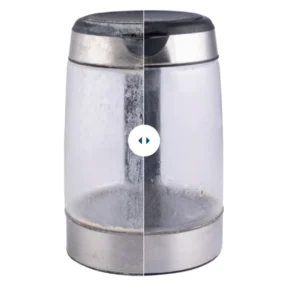
How to Remove Limescale from your Kettle
22 March 2024
View PostPosted on 15 September 2016 4 min read
Getting rid of limescale once it builds up can be a real challenge. If left unchecked, not only can it affect the performance of your heating system, but it can significantly shorten the lifespan of many expensive household products such as kettles, washing machines and boilers. Read more about what limescale is and its causes, or find out how to remove it below.
Despite all that, it’s actually easier than you might think to get rid of, and you can do it in a number of different, simple-to-follow ways:
The first point of call to get rid of limescale has to be one of the many household limescale cleaners which you can buy from any good supermarket or hardware store.
Simply follow the instructions on the bottle of whichever brand you’ve chosen, making sure it’s suitable to use on the affected area, and away you go. The downside of this option, however, is that it can be expensive, not 100% effective and also not great for the environment. And while it is possible to scrub most limescale off surfaces in kitchens or bathrooms with these standard cleaning products, if applied incorrectly these can cause lasting damage.
By far the best natural way to get rid of limescale is to use a mild acid such as vinegar or lemon juice.
This works by breaking down the limescale through a completely natural product; no bleach, no harmful chemicals. All you need to do is soak the affected area in the acid for at least an hour – that bit’s really important – after which point the limescale should easily wipe away.
For really tough stains you may need to repeat the process one more time before it’s 100% clean.
Yes, it does work – especially on the glass doors or screens surrounding your shower and bath.
The science bit is just the same; gently dry white wine (not you’re best stuff, of course!) works to remove limescale naturally by breaking down the calcium carbonate so it can easily be cleaned.
The only tricky part here comes if the glass you’re cleaning is upright and vertical – that makes the job of soaking the affected area difficult. That’s easily solved though; just apply it liberally and repeat the process a few times until the stains wipe away.
The cause of limescale is in your water.
It’s the minerals in hard water that get left behind once the water has dried, building up to form limescale over time.
Tap water hardness is different across the UK; that’s why some households suffer more from the problem of limescale than others. If limescale is causing you problems, the solution could be simpler and more long-lasting than any manual cleaning method out there. The answer could be softened water.
Arrange a demonstration with one of our expert team today and find out more about the link between limescale and hard water. They’ll give you a personalised quotation and demonstrate to you the difference that soft water can make to your home. Make limescale a thing of the past.
Research shows that limescale could be costing households in hard water areas an extra £180 a year on heating. With wholesale energy prices predicted to rise in 2021 and the cold weather set to stay for some time yet, many households will need to be savvy to reduce their energy bills.
As well as disrupting household heating systems, limescale is a household menace when it comes to cleaning, causing difficult stains around baths and basins, sinks, toilet bowls and shower heads. It can also significantly shorten the lifespan of many expensive household products such as kettles and washing machines. Thankfully, it’s actually easier than you might think to get rid of, and you can remove limescale from appliances like your kettle in a number of different, simple-to-follow ways.
The best way to prevent limescale build-up is to prevent the hard water that causes limescale from being present in the first place. Installing a non-electric water softener is a simple and longer-lasting solution than any manual cleaning method out there. Water softeners draw out the magnesium and calcium ions which make water hard and limit the accumulation of scale and scum, preserving the efficiency of heating systems.
If you have hard water in your home, the build-up of limescale could shorten the life of your household appliances. Water softeners remove minerals from your water supply and drastically reduce the amount of limescale in your home. Learn more about how our water softeners work and find the right model for you – choose from the new HarveyArc, the HVX, or the Big Blue.
Take the first step to banishing limescale and discover how a water softener works – click here to find out more!